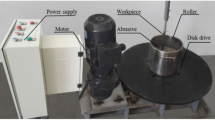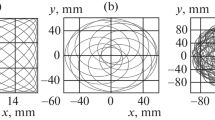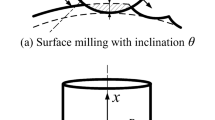Abstract
The spindle barrel finishing is commonly used to improve the surface integrity of the important parts of the high-end equipment while it is difficult to provide enough test artifacts for the traditional trial and error experiment to obtain the desirable processing technology. The EDEM simulation of the spindle barrel finishing can provide effective help for the process design. In this paper, simulations and experiments are conducted based on the identical apparatus and conditions to facilitate the comparison and validation between each other. The parameters required in the simulation are determined based on reliable experiments. In order to explain the interaction of ceramic media and metal workpieces in the finishing barrel, firstly, the depth of material wear on the surface of the workpiece is obtained, and the amount of material removal is calculated in conjunction with Archard wear theory based on the Hertz-Mindlin with Archard wear model in EDEM. The relationship between the amount of material removed and the time and position of workpiece clamping is quantified. It is in good agreement with the experimental results; the maximum deviation is 20.14%. The finishing mechanism is analyzed based on the motion trajectory of the barrel finishing media that are in contact with the workpiece observed in the simulation and the corresponding contact forces obtained from both the simulation and the experiment. Furthermore, the machining effect of the workpieces after the finishing process is discussed considering the analysis of the motion trajectory and the contact force. The achieved trajectories permit to calculate the active working time. This work provides an understanding of spindle barrel finishing process fundamentals and guidelines for optimal operating conditions.


























Similar content being viewed by others
References
Yang SQ, Li WH (2018) Surface finishing theory and new technology [M]. Springer.
Boschetto A, Bottini L, Veniali F (2018) Surface roughness and radiusing of Ti6Al4V selective laser melting-manufactured parts conditioned by barrel finishing [J]. Int J Adv Manuf Technol 94:2773–2790
Wang S, Timsit RS, Spelt JK (2000) Experimental investigation of vibratory finishing of aluminum. Wear 243(1):147–156
Rupinder S, Alok T, Sunpreet S (2017) Experimental investigation on shore hardness of barrel-finished FDM patterns [J]. Indian Acad Sci 20(9):1579–1584
Mark C (1995) Choosing the right media to meet mass finishing goals [J]. Met Finish 93(12)
Boschetto A, Veniali F (2009) Workpiece and media tracking in barrel finishing. Int J Mach Mach Mater 6(3/4):305–321
Li XH, Wu FF, L WH, Yang SQ (2017) Kinematic characteristics of mass finishing process with the parallel spindle: velocity measurement and analysis of the media. Adv Mech Eng 9(10):1–12
Wang XZ, Yang SQ, Li WH, Chen YN, Zhang QY (2017) Experimental investigation of adherent vibratory finishing for sheet specimens [J]. Surf Technol 10(46):261–267
Takahashi Y, Kataoka M, Uekusa M, Terumichi Y (2005) Behavior of three kinds of particles in rotary barrel with planetary rotation. Multibody Syst Dyn 13:195–209
Wang XZ, Yang SQ, Li WH, Wang YQ (2018) Vibratory finishing co-simulation based on ADAMS-EDEM with experimental validation. Int J Adv Manuf Technol 96:1175–1185
Li WH, Zhang L, Li XH, Yang SQ, Wu FF (2017) Theoretical and simulation analysis of abrasive particles in centrifugal barrel finishing: kinematics mechanism and distribution characteristics [J]. Powder Technol 318:518–527
Tian Y, Li WH (2015) Crankshaft barrel finishing mechanism analysis based on the discrete element method [J]. Modern Manuf Eng (03): 79-83.
Boschetto A, Ruggiero A, Veniali F (2007) Deburring of sheet metal by barrel finishing. Key Eng Mater 67:193–200
Boschetto A, Giordano V, Veniali F (2013) Micro-removal modeling of surface roughness in barrel finishing [J]. Int J Adv Manuf Technol 69:2343–2354
Cariapa V, Park H, Kim J, Cheng CJ, Evaristo A (2008) Development of a metal removal model using spherical ceramic media in a centrifugal disk mass finishing machine. Int J Adv Manuf Technol 39:92–106
Gates JD (1998) Two-body and three-body abrasion: a critical discussion. Wear 214:139–146
Archard JF (1953) Contact and rubbing of flat surfaces. J Appl Phys 24(8):981–988
Archard JF (1986) Friction between metal surfaces. Wear 113:3–16
Chen GM, Schott DL, Lodewijks G (2017) Sensitivity analysis of DEM prediction for sliding wear by single iron ore particle [J]. Eng Comput 34(6)
Popov VL (2010) Contact mechanics and friction: physical principles and applications Springer, Heidelberg-Dordrecht-London-New York.
Liu XY, Zhou SJ, Zhang XG (2009) Measurement of repose angle of solids in rotary kilns based on image processing [J]. Control Eng China 16(4):498–501
Elazazy MS, El-Hamshary M, Sakr M, Al-Easa HS (2018) Plackett-Burman and Box-Behnken designs as chemometric tools for micro-determination of L-Ornithine [J]. Spectrochim Acta A Mol Biomol Spectrosc 193:397–406
Diem-Mai KN, Tsuyoshi I, Thanh-Loc TD, Ariyo K, Takaya H, Koichi Y, Masahiko S (2018) Response surface method for modeling the removal of carbon dioxide from a simulated gas using water absorption enhanced with a liquid-film-forming device [J]. J Environ Sci 65:116–126
Reza OS, Othman HM, Jan V, Mohd RMH (2018) Determination of optimal mix from the standpoint of short term aging based on asphalt mixture fracture properties using response surface method [J]. Constr Build Mater 179:35–48
Funding
This project is supported is supported by General Program National Natural Science Foundation of China (Grant Number U1510118, 51875389, 51975399) and Key Program of Natural Science Foundation of Shanxi Province (Grant Number 201801D111002).
Author information
Authors and Affiliations
Corresponding author
Additional information
Publisher’s note
Springer Nature remains neutral with regard to jurisdictional claims in published maps and institutional affiliations.
Rights and permissions
About this article
Cite this article
Na, W., Tingting, Z., Sheng-qiang, Y. et al. Experiment and simulation analysis on the mechanism of the spindle barrel finishing. Int J Adv Manuf Technol 109, 57–74 (2020). https://doi.org/10.1007/s00170-020-05609-y
Received:
Accepted:
Published:
Issue Date:
DOI: https://doi.org/10.1007/s00170-020-05609-y




